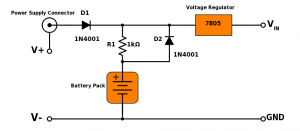This week we spent a lot of time preparing for our design review presentation. We finalized a lot of details that we had spent the majority of last week researching. Now that the designs have been primarily finalized, we have placed orders for the Zigbee shields, ESP32-C3 development boards, displays, and batteries. We decided on the approach to just purchase 2 Xbee hats in order to show that in the event of a wifi outage, we have a plan for how we can rely on a source other than the local network which we can explain how to scale up. While presentations lasted two days and we didn’t have that class time, we all met outside of class to work on the hardware we already had, research new parts that had gone out of stock since we requested them, and send out new orders.
This past week I started to plan out what should be included in the design report based on the provided guidelines. I went through a lot of different examples of reports from previous years and figured out what is most relevant and necessary to include regarding our specific project. For example, from the design presentation we learned that because we essentially have two MVPs: one for the node with the LEDs and another for the node with the display. With this information, we need to ensure that our design report goes into depth for the components that make up these different kinds of nodes. Furthermore, I think a good portion of our report is going to be dedicated to our design choices and how we got to our final design. This is because of all of the research and considerations last week that heavily influenced the design decisions we made for our presentation. With these in mind, I have a layout that I think makes the most sense to follow for our report. I believe I am on track with regards to our schedule and the next pressing item would be figuring out how to output to the display. While the displays have not come in yet that would be contingent on their arrival which I will touch on for my deliverables.
Regarding my deliverables for next week, on Friday, the ESP32s came in as well as the batteries and early next week we plan to see if we can interface with them. From the previous week we were able to test our temperature sensors with an Arduino, but now that we have our ESP32s it will be important to be able to interface with them and ensure that we know how to read and write data from our sensor readings. I anticipate there to be a learning curve but I am hoping that because of our extensive research into picking these boards we were able to prioritize the interfacing capability so that there would be documentation that we could follow. Ideally, our displays would arrive sometime before spring break and we can work on being able to display information that we program on the board. I anticipate this learning curve to be big as well despite choosing displays that are compatible with ESP32 so we would want to ensure that we plan accordingly while still being on track to complete our project. Regarding the nodes with the LEDs, that would depend on the output from our pathfinding algorithm as well but now that we have our ESP32s, we should be able to test that we are able to drive certain LEDs and not others instead of just testing with the Arduino like we had done last week. With these action items in mind, we will also be working on completing our design review report as the deadline is by the end of the week.






